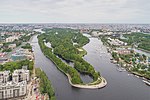Bolshoy Petrovsky Bridge

The Great or Bolshoi Petrovsky bridge is a bridge across Little Nevka in St. Petersburg, Russia, connecting Petrovsky Island with Krestovsky Island and passing over a small nameless islet on Little Nevka. It is very near the mouth of the river, which flows into the Finnish Gulf. A wooden draw bridge was built in 1838. In 1916 the bridge was accommodated to two-way vehicular traffic. In 1947 the bridge was upgraded, with the spans replaced by metal beams; it now measured 297 metres (974 ft) long and 18 metres (59 ft) wide. In December 1993, ice destroyed part of the bridge structure. After that, the bridge was closed to vehicular traffic; it was narrowed to 2.2 metres (7.2 ft) and was used only by pedestrians. The construction of a new bridge was started in 2009, and this opened in 2010. In the latter year, the old wooden bridge was dismantled.
Excerpt from the Wikipedia article Bolshoy Petrovsky Bridge (License: CC BY-SA 3.0, Authors, Images).Bolshoy Petrovsky Bridge
Savinoy Street, Saint Petersburg
Geographical coordinates (GPS) Address External links Nearby Places Show on map
Geographical coordinates (GPS)
| Latitude | Longitude |
|---|---|
| N 59.9648 ° | E 30.2548 ° |
Address
Большой Петровский мост
Savinoy Street
197110 Saint Petersburg (Петровский округ)
Saint Petersburg, Russia
Open on Google Maps









